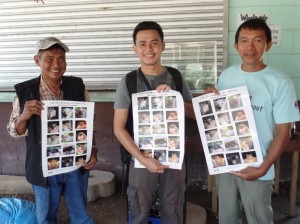The taxonomy and conservation of cave-dwelling bats in south central Mindanao remains undocumented and unexplored. This project was the first attempt to establish the first record of cave-dwelling bats in the region. A total of five caves were assessed from the village of Pisan, Kabacan, North Cotabato and identified a total of 14 cave-dwelling bat species with three species endemic in the country and one threatened species. Remarkably, cave sites we have assessed have relatively higher species composition after comparing our results with existing Mindanao cave studies.

Distribution of the poster ‘Cave-dwelling bats of Pisan Caves, Kabacan, Cotabato, Philippines’ with the village chieftain and co-official. The local government have agreed to have a meeting and consultation on the status and conservation management plan for bat caves in the area
Despite of this noteworthy result, continuous anthropogenic activities imperils bat population in caves. Hunting and unregulated tourism and cave entry were among the pressures to cave and bats. Community discussion revealed that bats were hunted for food and trade in local households. Hunters prefer to harvest large roosting bat species such Rousettus amplexicaudatus, Eonycteris spelaea and Hipposideros diadema because they are abundant and their meat are then sold at a very low-price compared to known price in other areas. All caves were visited for tourism and other leisure activities such as spelunking and camping. Unregulated tourism in caves contributes to the pressures in cave sites. Presence of extensive vandalism in walls, damaged structures, and lighting use inside caves were evidence of bat cave mismanagement. The vulnerability of caves to encroachment is associated with the accessibility to cave where sites with large openings and near human settlements are heavily exploited. Another factor contributing to this mismanagement was the poor community understanding of the presence of cave bats and the ecological services they provide. A series of conservation education programs in the community and training of students for future cave bat studies was spearheaded in cooperation of the conservation group of the Department of Biological Sciences, University of Southern Mindanao with the hope to escalate cave bat understanding and appreciation that will lead to their protection.
With the information on hand, strengthening the started efforts and forging partnership with various stakeholders is an essential next-step forward to conserve the threatened population of cave bats in south central Mindanao. Coordination and presentation of results and conservation concerns in caves were steered among the local government unit and the environmental office of the village. Recently, with the new leadership of the village chieftain, we agreed to meet various stakeholders of the village that includes the tourism officers, ethnic indigenous groups, farmers, cavers, and communities residing near the caves to discuss the wealth (bats), conservation concerns, and management plan to create a sustainable cave system that will benefit the bats, the ecosystem and the people.
YOU CAN DOWNLOAD THE POSTER FROM OUR PHILIPPINE OUTREACH PAGE
Krizler C. Tanalgo was a grantee of the SEABCRU Small Grant for Southeast Asian Students 2012
